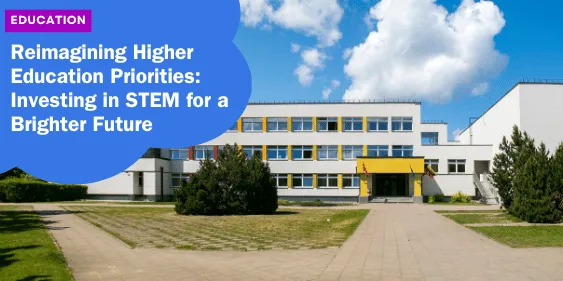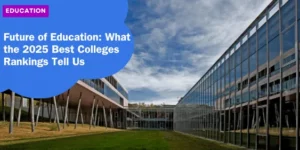Reimagining Higher Education Priorities: Investing in STEM for a Brighter Future

Rebalancing Higher Education Priorities
In recent times, the conversation surrounding higher education has intensified, focusing on whether current funding allocations effectively meet the evolving demands of our economy and society.
With an increasing array of degree programs available, it’s essential to evaluate if these investments are aligning with our future needs.
This discussion prompts a vital question: Are we directing resources toward the most impactful areas?
Examining the Existing Discrepancies
The higher education landscape currently exhibits a disproportionate focus on degrees that may not align with market needs.
While degrees in liberal arts and traditional fields offer intellectual enrichment, they do not always correlate with job security or economic growth.
Concurrently, the swift evolution of technology has created a pressing demand for skilled professionals in science, technology, engineering, and mathematics (STEM) fields.
This disconnect between educational outputs and labor market requirements indicates a potential need for a strategic realignment of funding.
The Promise of Strategic Reallocation
Envision the potential if funding were redirected from underperforming programs—those with lower employment rates and return on investment—toward STEM fields.
Such a shift could enhance economic growth by cultivating a workforce skilled in high-demand sectors.
This reallocation could lead to increased earnings and job satisfaction for individuals, while also driving societal progress through STEM innovations addressing global challenges like health crises and climate change.
However, this realignment is not merely about reducing funds; it’s about strategic investment.
The aim is to foster a symbiotic relationship between educational institutions and the broader economy, enabling both to thrive.
By investing more heavily in STEM, we are not only addressing immediate skill gaps but also laying the groundwork for future advancements that could revolutionize various industries.
The Case for Investing in STEM
STEM education is pivotal for driving economic growth, fostering innovation, and maintaining global competitiveness.
Here’s why investing in STEM is crucial:
Economic Growth Powered by STEM
The link between STEM education and economic prosperity is well-established.
According to the Bureau of Labor Statistics, STEM occupations are projected to grow by 8% from 2019 to 2029, compared to just 3.7% for non-STEM jobs.
This statistic highlights where future job markets are heading. Investing in STEM programs not only fills existing roles but also generates new opportunities in cutting-edge fields such as artificial intelligence and renewable energy.
The broader impact? A more resilient economy characterized by higher-paying jobs and innovative industries.
Fostering Innovation Across Borders
Innovation transcends borders, making a strong STEM foundation essential for international competitiveness.
Countries like South Korea and Germany have long recognized this, investing heavily in STEM education and reaping benefits through high-tech exports and groundbreaking research.
By redirecting funds toward STEM degrees, we set the stage for breakthroughs that enhance our global standing. Today’s STEM students are poised to become tomorrow’s leaders in research and innovation.
Addressing Skill Shortages Directly
Many employers are grappling with skill shortages in STEM fields. Redirecting funding toward these programs directly addresses this issue.
By developing a talent pipeline equipped with essential skills, we not only meet current industry demands but also anticipate future needs.
This approach ensures a workforce that can adapt to rapid technological advancements, maintaining economic resilience amid evolving market trends.
Advancing Public Health and Environmental Sustainability
STEM fields are at the forefront of addressing critical societal challenges, including public health and environmental sustainability.
With pressing issues like climate change and global pandemics, investing in STEM translates into more research and development in areas such as renewable energy, biotechnology, and environmental conservation.
Prioritizing STEM not only improves current conditions but also safeguards the planet for future generations.
Navigating the Potential Risks
Despite the clear benefits, concerns about potential coercion in higher education arise.
There’s a risk that increased focus on STEM could pressure students into these fields, overshadowing their true interests.
It is essential to address these concerns effectively to ensure that the shift in funding does not lead to undue pressure on students.
Addressing Coercion Concerns in Education
A shift in funding priorities might unintentionally suggest that STEM is the only valuable path, creating undue pressure on students.
To mitigate this, it’s crucial to promote a balanced approach that showcases STEM as one of many viable options.
Transparent guidance and supportive measures can help students understand the benefits of STEM without feeling compelled to choose it solely for economic reasons.
Transparent Communication & Incentives
Effective communication is key to helping students appreciate the value of STEM without feeling pressured.
By presenting STEM as an option among many, educators can foster a natural alignment of student interests with market needs.
Incentives such as scholarships, mentorships, and clear career pathways can highlight the benefits of STEM while respecting students’ diverse interests.
This approach ensures that students make informed decisions about their careers, guided by their passions and strengths.
Ensuring Educational Excellence and Economic Growth
Investing strategically in STEM goes beyond merely allocating funds; it involves nurturing an ecosystem that prioritizes educational excellence and economic advancement.
Here’s what this investment entails:
Promoting Educational Excellence Through STEM
A focus on STEM fosters educational excellence by equipping students with the skills necessary for success in a dynamic job market.
Technological advancements over recent decades illustrate the rapid pace of industry evolution, emphasizing the need for a workforce adept at keeping up.
Investing in STEM education not only enhances academic standards but also prepares students for future challenges by promoting critical thinking and problem-solving skills.
Driving Economic Advancement Through STEM Investment
STEM fields are crucial for unlocking new industries and job opportunities. Investing in STEM creates a foundation for entire sectors to flourish, addressing skills gaps and ensuring that graduates are well-prepared for the job market.
Fields like renewable energy exemplify how STEM investment can lead to both environmental and economic benefits, creating a more sustainable and prosperous future.
Anticipating Positive Outcomes
Strategic investment in STEM is expected to yield significant outcomes, including higher wages and increased career opportunities.
Data consistently shows that STEM careers offer salaries above the national average, contributing to greater economic security and prosperity.
Additionally, STEM graduates will have access to opportunities in innovative fields, contributing to societal advancements and pushing the boundaries of knowledge.
Long-Term Societal Benefits of STEM Focus
The long-term benefits of investing in STEM are profound.
Beyond individual success, a strong STEM workforce enhances societal resilience and adaptability.
By promoting diversity within STEM fields, we ensure that a range of perspectives contribute to solving complex global issues.
This diverse input is essential for achieving breakthroughs that benefit all sectors of society.
Shaping the Future of Higher Education
As we navigate the evolving landscape of higher education, the impact of rebalancing priorities extends far beyond individual campuses.
Shifting focus toward STEM education prepares students for future challenges and drives technological advancements, healthcare improvements, and environmental solutions.
This transformation calls for a collaborative effort among all stakeholders, including university administrators, policymakers, industry leaders, educators, and students.
A Call to Action
The current moment is pivotal. We must design a strategy that not only elevates STEM but also respects the value of diverse academic disciplines.
This approach ensures that higher education fosters a well-rounded educational environment, preparing students for a range of careers while addressing market needs.
Conclusion
Rebalancing higher education priorities is more than an administrative task; it is a societal imperative.
By thoughtfully investing in STEM while valuing other disciplines, we build a foundation for a brighter, more resilient future.
The time to act is now, and the responsibility lies with each of us to ensure that our educational system evolves to meet the needs of tomorrow’s world.






